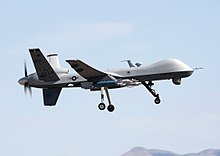Drones
This learning resource focuses on the application of drones in science and technologie as Unmanned aerial vehicle (UAV)



Classification of Drones
editWe can describe classify drones in the area of Science and technology as Unmanned aerial vehicle (UAV). A UAV can be defined as aircraft without a human pilot aboard, that could be used with different by the area of application:
- Agricultural drone
- Drone Mapping
- Delivery drone
- Micro air vehicle
- Passenger Drones or Drone Taxis
- Unmanned Combat Aerial vehicle (UCAV), i.e. a UAV that carries aircraft ordnance
Furthermore the drones can be classified by size and technology, that provides constraints and requirements of the application
Learning Tasks
edit- (Agricultural Drones) Analyse the concept of Precision Agriculture and describe in a comparative analysis the pros and cons in comparison to satellite technology (e.g. covering large areas, revisit time for satellites, tailored applications, legal constraints of application, ...)
- (Low-Cost Technology) Analyse the concept of low-cost technology and discuss if this concept is applicable to drones. What are the challenges, requirements and constraints for application in developing countries in term of Sustainability
- (Delivery of Goods) Explain how drones can be used to transport medical samples and drugs in remote areas. What are the requirements and constraints of application of drones for that purpose (range, distance, transport capacities,) and what are the benefits of that purpose?
- (Remote Sensing) Remote sensing can be performed with Satellite Technology and with drones. Compare those two approaches and analyse PROs and CONs of the different approaches!
Disambiguation
editPage Information
editThis page was based on the following wikipedia-source page: